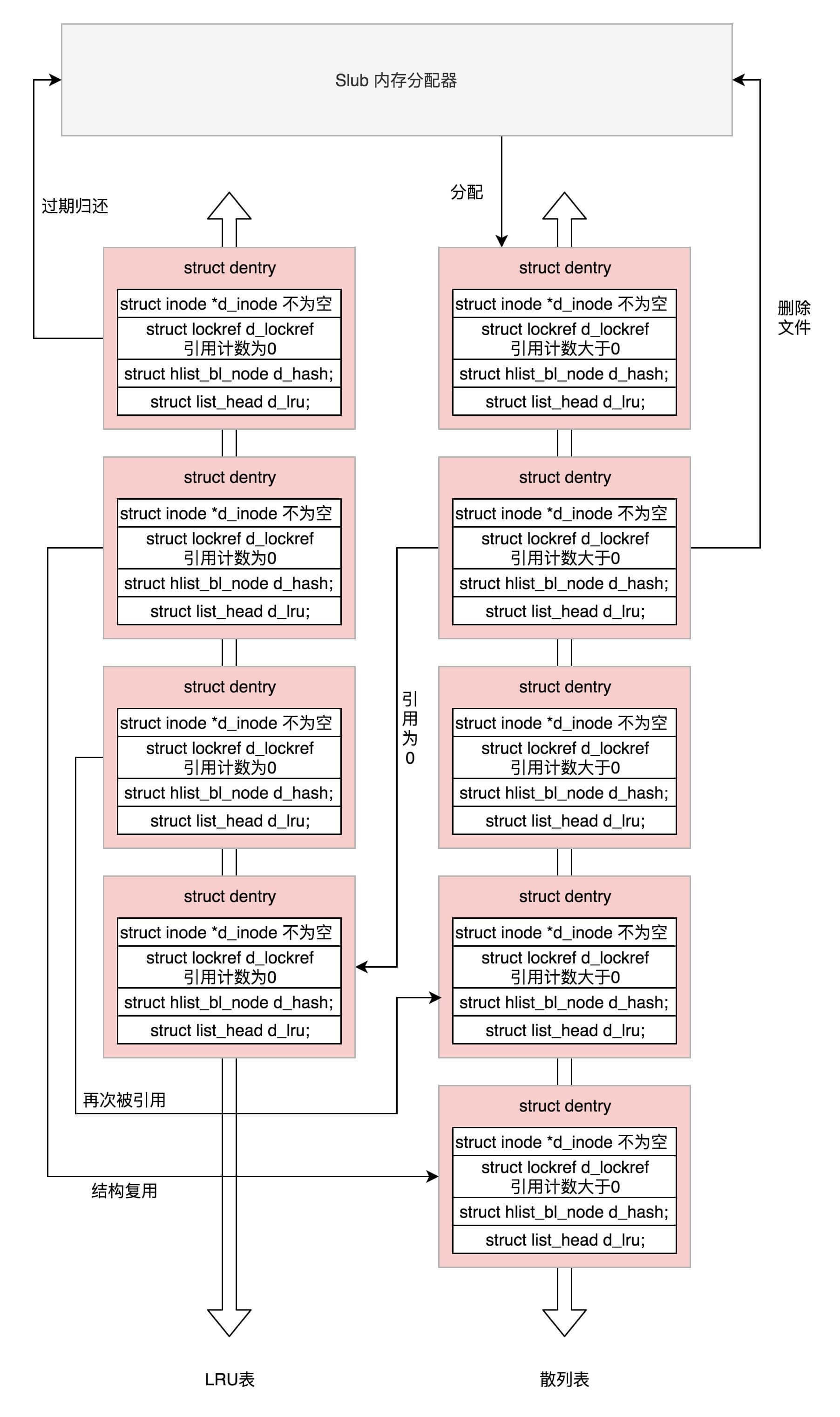Linux文件系统(三)虚拟文件系统
Linux文件系统
Linux文件系统(一)文件系统概述
Linux文件系统(二)磁盘文件系统
Linux文件系统(三)虚拟文件系统
Linux文件系统(四)文件缓存
Linux文件系统(三)虚拟文件系统
文章目录
- Linux文件系统(三)虚拟文件系统
- 一、文件系统框架
- 二、挂载文件系统
- 三、打开文件
- 四、总结
一、文件系统框架
文件系统需要许多层的组件一起协作,具体怎么协作,下面来看一看

- 在应用层,进程操作文件可以通过 open、read、write 等系统调用
- 在内核,每个进程都需要对其打开的文件,维护一定的数据结构
- 在内核,整个系统打开的文件,也需要维护一定的数据结构
- Linux可以支持多大数十种文件系统格式,每种文件系统的实现各不相同,为了统一操作,Linux提供的虚拟文件系统这一接口。它提供了常见的文件系统对象模型,例如 inode、directory entry、mount等,以及这些对象的操作方法,例如 inode operations、directory operations、file operations 等
- 然后对接的是真正的文件系统,例如 ext4
- 为了读取 ext4 文件系统,要通过块设备 I/O 层,也即 BIO 层。这是文件系统层和块设备驱动层的接口
- 为了加快读写速度,还有一个缓存层
- 最下面的就是块设备驱动程序了
通过系统调用分析内核架构是一种很好的方式,下面将分析这两个系统调用
- mount:挂载文件系统
- open:打开文件,如果文件不存在并且指定了 O_CREAT,那么就创建一个文件
二、挂载文件系统
想要操作文件系统,第一步就是挂载文件系统
内核是否支持某种文件系统,那要看内核是否已经注册了某种文件系统。例如 ext4 文件系统,就需要通过 register_filesystem 进行注册,传入的参数是 ext4_fs_type,表示注册的是 ext4 文件系统类型。这里面有一个重要的成员变量 ext4_mount,请记住它,后面会再谈到
register_filesystem(&ext4_fs_type);static struct file_system_type ext4_fs_type = {.owner = THIS_MODULE,.name = "ext4",.mount = ext4_mount,.kill_sb = kill_block_super,.fs_flags = FS_REQUIRES_DEV,};
挂载文件系统通过系统调用 sys_mount 来操作,定义如下
SYSCALL_DEFINE5(mount, char __user *, dev_name, char __user *, dir_name, char __user *, type, unsigned long, flags, void __user *, data){......ret = do_mount(kernel_dev, dir_name, kernel_type, flags, options);......}
接下来的调用链为:do_mount -> do_new_mount -> vfs_kern_mount
struct vfsmount *vfs_kern_mount(struct file_system_type *type, int flags, const char *name, void *data){......mnt = alloc_vfsmnt(name);......root = mount_fs(type, flags, name, data);......mnt->mnt.mnt_root = root;mnt->mnt.mnt_sb = root->d_sb;mnt->mnt_mountpoint = mnt->mnt.mnt_root;mnt->mnt_parent = mnt;list_add_tail(&mnt->mnt_instance, &root->d_sb->s_mounts);return &mnt->mnt;}
首先创建一个 struct mount 结构,每一个被挂载的文件系统在内核中都对应这样一个结构,定义如下
struct mount {struct hlist_node mnt_hash;struct mount *mnt_parent;struct dentry *mnt_mountpoint;struct vfsmount mnt;union {struct rcu_head mnt_rcu;struct llist_node mnt_llist;};struct list_head mnt_mounts; /* list of children, anchored here */struct list_head mnt_child; /* and going through their mnt_child */struct list_head mnt_instance; /* mount instance on sb->s_mounts */const char *mnt_devname; /* Name of device e.g. /dev/dsk/hda1 */struct list_head mnt_list;......} __randomize_layout;struct vfsmount {struct dentry *mnt_root; /* root of the mounted tree */struct super_block *mnt_sb; /* pointer to superblock */int mnt_flags;} __randomize_layout;
- mnt_parent:挂载点所在的文件系统对应的 struct mount
mnt_mountpoint:挂载点在父文件系统的 dentry
struct dentry 表示目录项对象,并于对应的目录或文件的inode关联
- mnt_root:当前文件系统根目录的dentry
- mnt_sb:指向超级块
接下来调用 mount_fs 挂载文件系统
struct dentry *mount_fs(struct file_system_type *type, int flags, const char *name, void *data){struct dentry *root;struct super_block *sb;......root = type->mount(type, flags, name, data);......sb = root->d_sb;......}
这里调用了 type->mount,如果是ext4,那么就对应上面提到的 ext4_mount,通过这个函数,从文件系统中获得超级块。在文件系统的实现中,每个在磁盘中的结构,在内存中也对应相同形式的结构,当所有的数据结构读到内存中,内核就可以通过操作这些数据结构,来操作文件系统了
下面举一个例子,来解析 mount 之后,各数据结构之间的关系
假设根文件系统下面有一个目录 home,然后将另一个文件系统A挂载到根文件系统的 home 目录下面。在文件系统A的根目录下面,有一个文件夹 hello,所以就有了 /home/hello 目录。然后将文件系统B挂载到 /home/hello 目录下,而文件系统B根目录下面有一个文件夹 work,work 下面有一个文件夹 data,所以就有了目录 /home/hello/work/data
为了维护这些关系,内核创建并维护了这些数据结构,如下图

黄色部分为 struct mount,每个被挂载的文件系统在内核中都对应一个 struct mount
绿色部分为 struct file,每个打开的文件都有一个 struct file,里面有两个变量,一个指向对应的 struct mount,一个指向对应的 struct dentry
红色部分为 struct dentry,叫做目录项对象,每个目录或者文件都对应一个 struct dentry,用于与 inode 相关联
三、打开文件
打开文件通过系统调用 sys_open,定义如下
SYSCALL_DEFINE3(open, const char __user *, filename, int, flags, umode_t, mode){......return do_sys_open(AT_FDCWD, filename, flags, mode);}long do_sys_open(int dfd, const char __user *filename, int flags, umode_t mode){......fd = get_unused_fd_flags(flags);if (fd >= 0) {struct file *f = do_filp_open(dfd, tmp, &op);if (IS_ERR(f)) {put_unused_fd(fd);fd = PTR_ERR(f);} else {fsnotify_open(f);fd_install(fd, f);}}putname(tmp);return fd;}
要打开一个文件,首先要通过 get_unused_fd_flags 获取一个没有用的文件描述符,如何获取没有用的文件描述符呢?
每个进程 task_struct 都有一个 files_struct
struct files_struct *files;
files_struct 里面有一个文件描述符数组
struct files_struct {......struct file __rcu * fd_array[NR_OPEN_DEFAULT];};
每打开一个文件,就会在这个数组中找到第一个未被使用的项,下标就是文件描述符
对于一个进程,默认的文件描述符0就是 stdin,文件描述符1就是 stdout,文件描述符2就是 stderr
文件描述符数组中的每一项都是一个 struct file 指针,也就是说,每一个打开的文件都对应一个 struct file
do_sys_open 中调用 do_filp_open,就是创建这个 struct file 结构,然后 fd_install(fd, f) 是将文件描述符和这个结构体关联起来
struct file *do_filp_open(int dfd, struct filename *pathname,const struct open_flags *op){......set_nameidata(&nd, dfd, pathname);filp = path_openat(&nd, op, flags | LOOKUP_RCU);......restore_nameidata();return filp;}
do_filp_open 首先调用 set_nameidata 解析路径,我们知道文件就是一串的路径名称,需要逐个解析。这个结构就是解析和查找路径的时候做辅助作用
在 struct nameidata 有一个关键的成员变量 struct path
struct path {struct vfsmount *mnt;struct dentry *dentry;} __randomize_layout;
其中的 struct vfs_mount 与文件系统的挂载有关。另一个是 struct dentry,可以用来表示目录和文件,建立文件名和 inode 之间的关联
接下来是 path_openat,主要做以下几件事
static struct file *path_openat(struct nameidata *nd,const struct open_flags *op, unsigned flags){......file = get_empty_filp();......s = path_init(nd, flags);......while (!(error = link_path_walk(s, nd)) &&(error = do_last(nd, file, op, &opened)) > 0) {......}terminate_walk(nd);......return file;}
- get_empty_filp:生成一个 struct file 结构
- path_init:初始化 nameidata,准备开始节点路径查找
- link_path_walk:对于路径名逐层进行文件节点的查找
- do_last:获取文件对应的 inode 对象,并且初始化 file 对象
例如,文件 /root/hello/work/data,link_path_walk 会解析前面的路径部分 /root/hello/work,解析完毕后,nameidata 的 dentry 就是路径最后的上一级目录对应的 dentry,这里是 work,而 nameidata 的filename 为路径的最后一部分 data,解析完后之后,交给 do_last 做下一步处理
do_last 的定义如下
static int do_last(struct nameidata *nd,struct file *file, const struct open_flags *op,int *opened){......error = lookup_fast(nd, &path, &inode, &seq);......error = lookup_open(nd, &path, file, op, got_write, opened);......error = vfs_open(&nd->path, file, current_cred());......}
在这里面,我们需要先查找文件路径最后一部分对应的 dentry,如何查找呢?
Linux 为了提高目录项对象的处理效率,实现了目录项高速缓存 dentry cache,简称 dcache,它主要由两个数据结构组成
- 哈希表 dentry_hashtable:dcache 中的所有 dentry 对象都通过 d_hash 指针链到相应的 dentry 哈希表中
- 未使用的 dentry 对象链表 s_dentry_lru:dentry 对象通过其 d_lru 指针链入 LRU 链表中。LRU 的意思是最近最少使用

这两个列表会产生复杂的关系:
- 引用次数为0:一个散列表的 dentry 没有被引用,就会加到LRU链表中
- 再次被引用:一个在LRU链表中的 dentry 再次被引用了,则从LRU链表中移除
- 分配:当 dentry 在散列表中没有找到,则从 Slub 分配器中分配
- 过期归还:当LRU链表中最长时间没有被使用的 dentry 应该释放回 Slub 分配器
- 文件删除:文件被删除了,相应的 dentry 应该释放回 Slub 分配器
- 结构复用:当需要分配一个 dentry,但是无法分配新的,就从LRU链表中取出一个来复用
所以,do_last 在查找 dentry 的时候,会先从缓存中查找,调用的是 lookup_fast
如果缓存中没有找到,那么就需要到文件系统中查找,通过 lookup_open 实现,定义如下
static int lookup_open(struct nameidata *nd, struct path *path,struct file *file,const struct open_flags *op,bool got_write, int *opened){......dentry = d_alloc_parallel(dir, &nd->last, &wq);......struct dentry *res = dir_inode->i_op->lookup(dir_inode, dentry,nd->flags);......path->dentry = dentry;path->mnt = nd->path.mnt;}const struct inode_operations ext4_dir_inode_operations = {.create = ext4_create,.lookup = ext4_lookup,...
lookup_open 会创建一个新的 dentry,然后调用上一级目录的 inode 的 inode_operations 的 lookup 函数,对于 ext4 文件系统来说,调用的是 ext4_lookup,会到文件系统中去寻找 inode,找到后将新生成的 dentry 赋给 path 变量
do_last 最后一步调用的是 vfs_open
int vfs_open(const struct path *path, struct file *file,const struct cred *cred){struct dentry *dentry = d_real(path->dentry, NULL, file->f_flags, 0);......file->f_path = *path;return do_dentry_open(file, d_backing_inode(dentry), NULL, cred);}static int do_dentry_open(struct file *f,struct inode *inode,int (*open)(struct inode *, struct file *),const struct cred *cred){......f->f_mode = OPEN_FMODE(f->f_flags) | FMODE_LSEEK |FMODE_PREAD | FMODE_PWRITE;path_get(&f->f_path);f->f_inode = inode;f->f_mapping = inode->i_mapping;......f->f_op = fops_get(inode->i_fop);......open = f->f_op->open;......error = open(inode, f);......f->f_flags &= ~(O_CREAT | O_EXCL | O_NOCTTY | O_TRUNC);file_ra_state_init(&f->f_ra, f->f_mapping->host->i_mapping);return 0;......}const struct file_operations ext4_file_operations = {.......open = ext4_file_open,......};
vfs_open 最重要的一件事就是,调用 f_open->open,也就是 ext4_file_open。另外还有一件重要的事情就是将打开文件的所有信息天道 struct file 结构中
struct file {union {struct llist_node fu_llist;struct rcu_head fu_rcuhead;} f_u;struct path f_path;struct inode *f_inode; /* cached value */const struct file_operations *f_op;spinlock_t f_lock;enum rw_hint f_write_hint;atomic_long_t f_count;unsigned int f_flags;fmode_t f_mode;struct mutex f_pos_lock;loff_t f_pos;struct fown_struct f_owner;const struct cred *f_cred;......struct address_space *f_mapping;errseq_t f_wb_err;}
四、总结
下面这张图总结了文件系统中每个结构之间的关系

对于每一个进程,都有一个文件描述符数组,数组的下标是文件描述符,数组项指向打开文件对应的 struct file 结构
struct file 中有变量指向文件对应的 inode,还有关于文件的操作集 file_operations,这个操作集根据文件系统类型不同而不同
每一个打开的文件都有一个对应的 struct dentry,虽然叫做目录项对象,但是它不仅表示目录,还可以表示文件,它的重要作用就是指向该文件对应的 inode
dentry 是放在 dentry cache 中,如果文件关闭了,它依旧存在,它可以长期维护文件路径和硬盘上文件的关系





























还没有评论,来说两句吧...